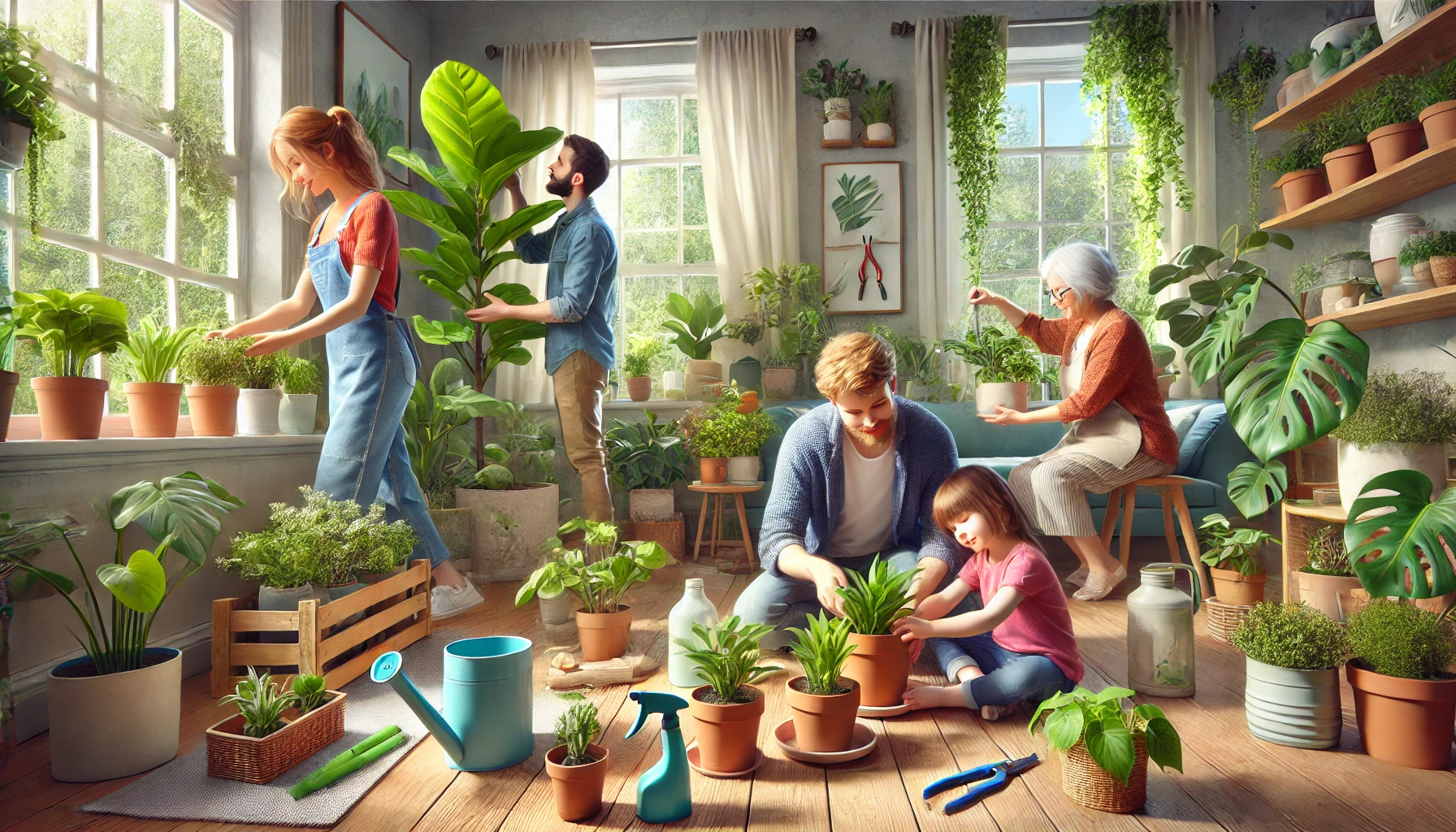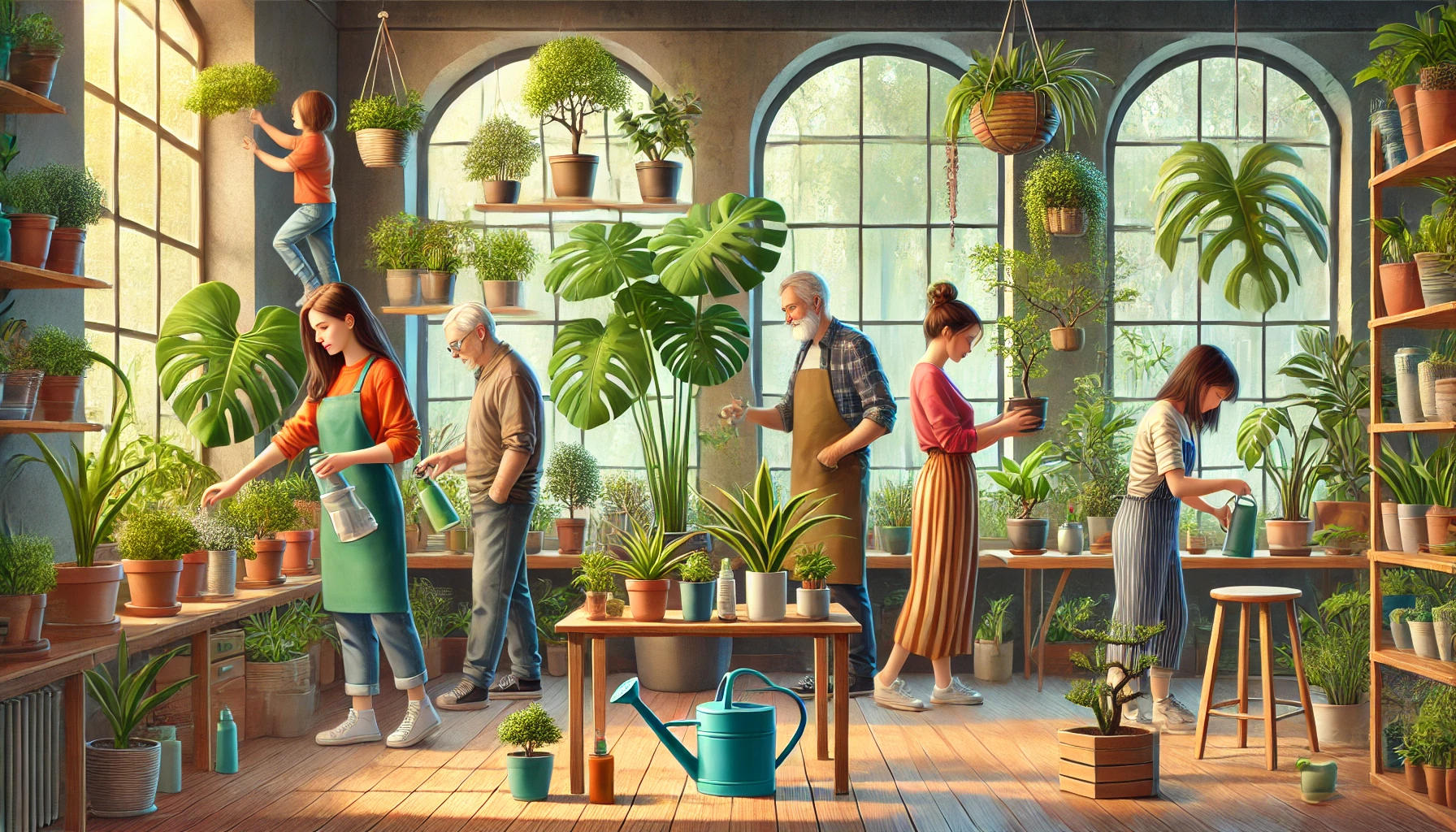Houseplants have become an essential part of modern living spaces, transforming homes into lush green retreats while offering a host of health and wellness benefits. But caring for houseplants requires more than just occasional watering.
It’s about understanding their needs and nurturing them to thrive indoors. Whether you’re a seasoned green thumb or a complete beginner, mastering the basics of common houseplant care is key to keeping your plants happy and healthy.
Why is Houseplant Care Important?
Taking care of indoor plants not only enhances the beauty of your living space but also improves air quality, reduces stress, and creates a calming atmosphere. In recent years, houseplants like the Monstera deliciosa, Snake Plant, Pothos, and Peace Lily have grown in popularity.
These low-maintenance favorites make it easy for anyone to enjoy the benefits of indoor greenery. With the increased interest in plant care, more people are discovering how fulfilling it can be to nurture these living companions.
Many houseplant enthusiasts also incorporate indoor plant trees like fiddle-leaf figs and rubber plants, which add vertical beauty and purify indoor air.
Mastering Plant Living Conditions
A healthy houseplant starts with providing the right living conditions. While it may seem simple at first, mastering the balance between light, temperature, and humidity is crucial to keeping your plants thriving.
- Light: Light is a plant’s primary source of energy. Some plants, like succulents and cacti, thrive in bright, direct sunlight, while others, such as ferns and peace lilies, prefer low to medium indirect light. Observe how much light each part of your home receives throughout the day and match your plants to their ideal conditions.
- Temperature and Humidity: Most houseplants come from tropical regions and prefer a warm environment with moderate to high humidity. Avoid placing your plants near drafts, heating vents, or air conditioning units, as sudden changes in temperature can cause stress. Misting your plants or using a humidifier can help maintain the right humidity levels.
- Pot Size and Soil: The size of the pot affects root development and overall plant health. Plants with fast-growing roots may outgrow their pots quickly, leading to root-bound conditions. Choose well-draining pots with adequate drainage holes, and use the right soil mix for your specific plant. Succulents require a sandy, well-draining mix, while leafy green plants prefer a rich, moisture-retentive blend.
Understanding your plant’s specific environmental needs will help you create a thriving indoor garden that grows and flourishes over time.
For those with limited space, indoor vertical planters are a great way to maximize plant growth while keeping your home organized and stylish
The Art of Watering: How Often Should You Water the Average House Plant?
Watering is one of the most misunderstood aspects of houseplant care. Overwatering is the leading cause of houseplant death, while underwatering can leave your plants weak and dry. Finding the right balance is essential for long-term success.
Several factors influence how often you should water your houseplants:
- Plant type: Succulents and cacti need infrequent watering, often once every two to three weeks, while tropical plants like ferns may require weekly watering.
- Season: Houseplants typically need more water during their active growing season (spring and summer) and less during the dormant months of fall and winter.
- Light and temperature: Plants in bright, warm spots will dry out more quickly than those in shaded areas.
If you’re looking for an easy way to display plants while maintaining optimal watering routines, consider installing an indoor living wall planter filled with resilient greenery like pothos and philodendrons.
How to Know When Your Plant Needs Water
- Check the soil moisture with your finger—if the top inch of soil feels dry, it’s time to water.
- Use a moisture meter for more accuracy.
- Look for signs of underwatering, such as wilting or dry, crispy leaves, and signs of overwatering, like yellowing leaves and soggy soil.
Overwatering vs. Underwatering: What’s Worse?
Overwatering can lead to root rot, a condition that’s often fatal for houseplants. On the other hand, underwatering is usually easier to fix—plants can recover from a little dryness, but they’ll struggle to survive soggy roots.
A Simple Watering Guide by Plant Type
- Succulents and Cacti: Water every 2–3 weeks, allowing the soil to dry completely between waterings.
- Tropical Plants (Monstera, Philodendron, Pothos): Water when the top inch of soil is dry, typically once a week.
- Ferns: Keep the soil consistently moist but not soggy; water once or twice a week.
- Peace Lily: Water when the leaves begin to droop slightly—usually once a week.
Troubleshooting Common Problems: Why Do Indoor Plant Leaves Turn Yellow?
Indoor plants bring life, color, and freshness to any space, but nothing is more frustrating than watching their leaves turn yellow. While some leaf yellowing is natural as plants age, excessive yellowing is usually a sign of an underlying problem. If you’re wondering why your plant’s leaves are changing color, here are the most common causes and solutions.
Potential Reasons for Yellow Leaves
1. Nutrient Deficiency
Plants require a balance of essential nutrients like nitrogen, magnesium, and iron to maintain their lush green appearance. A lack of these nutrients can cause yellowing leaves, especially in older foliage.
Solution: Use a balanced, water-soluble fertilizer suitable for your specific plant type. Consider using a soil test kit to identify nutrient deficiencies.
2. Overwatering or Poor Drainage
One of the most common reasons for yellow leaves is overwatering. Too much water suffocates the roots, leading to root rot, which in turn prevents the plant from absorbing nutrients effectively.
Solution: Water only when the top inch of soil feels dry. Ensure pots have drainage holes and avoid letting plants sit in standing water.
3. Inconsistent Light Exposure
Too much direct sunlight can scorch leaves, while too little light can cause them to turn yellow due to reduced chlorophyll production.
Solution: Research the lighting needs of your plant and adjust its placement accordingly. Rotate plants occasionally to ensure even light distribution.
4. Pests and Diseases
Common indoor plant pests, such as spider mites, aphids, and mealybugs, suck nutrients from the leaves, causing yellowing. Fungal infections can also lead to discoloration.
Solution: Inspect plants regularly for pests. If you spot any, wipe the leaves with neem oil or use insecticidal soap. Ensure good airflow around your plants to prevent fungal infections.
5. Temperature Stress
Exposure to extreme temperatures—whether too hot or too cold—can stress plants and lead to yellowing leaves.
Solution: Keep plants away from direct heat sources, air conditioning vents, or drafty windows. Most houseplants thrive in temperatures between 65-75°F (18-24°C).
By addressing these issues, you can help restore your plant’s vibrant green color and overall health.

Purifiers of the Air: What Plant Removes 78% of Airborne Mold?
If you’re looking for a natural way to improve indoor air quality, the peace lily (Spathiphyllum) is one of the best choices. This elegant and low-maintenance plant is known for its air-purifying abilities, including removing up to 78% of airborne mold spores.
How Peace Lilies Improve Indoor Air Quality
Peace lilies are excellent at absorbing toxins such as formaldehyde, benzene, and carbon monoxide. They also regulate humidity, making them particularly useful in damp environments where mold spores thrive. The plant’s broad leaves help trap and neutralize airborne pollutants, making it a great choice for bedrooms, bathrooms, and living rooms.
Why Peace Lilies Are a Favorite Among Plant Lovers
- Low Maintenance: They thrive in low to moderate light conditions, making them perfect for indoor spaces with limited sunlight.
- Air-Purifying Properties: NASA’s Clean Air Study confirmed that peace lilies help remove harmful airborne toxins.
- Aesthetic Appeal: Their deep green leaves and striking white blooms make them a visually appealing addition to any home.
Care Tips to Maximize Benefits
- Watering: Keep the soil consistently moist but not soggy. Peace lilies prefer slightly humid conditions.
- Light Requirements: They do best in indirect, bright light but can also tolerate low-light conditions.
- Cleaning the Leaves: Dust accumulates on their leaves, reducing their ability to purify air. Wipe them down with a damp cloth every few weeks.
- Repotting: Every couple of years, repot to refresh the soil and encourage continued growth.
By adding a peace lily to your home, you not only enhance the aesthetics but also create a cleaner, healthier indoor environment.
Concluding with Confidence: Encouraging Everyday Plant Care
Caring for indoor plants is a rewarding experience that enhances your home’s atmosphere and improves well-being. Whether you’re troubleshooting yellowing leaves or looking for an air-purifying powerhouse like the peace lily, small efforts can lead to thriving, beautiful plants.
Key Takeaways and Actionable Tips
✅ Monitor watering habits—avoid overwatering but don’t let the soil dry out completely.
✅ Ensure proper lighting—understand your plant’s specific needs.
✅ Keep an eye out for pests—early detection prevents major damage.
✅ Choose air-purifying plants like peace lilies for a healthier home environment.
If you’re new to plant care, start simple. Choose low-maintenance plants, observe their behavior, and gradually expand your collection.
Online Resources & Communities for Plant Enthusiasts
Want to connect with fellow plant lovers? Check out these resources:
Reddit Communities: r/houseplants, r/plantclinic
Facebook Groups: “Houseplant Hobbyist,” “Plant Swap & Care”
YouTube Channels: Planterina, Summer Rayne Oakes
By learning, experimenting, and engaging with other plant enthusiasts, you’ll develop the confidence and knowledge needed to create a flourishing indoor garden.


Houseplants are basically the best kind of roommates—low maintenance (mostly), always there to brighten up the place, and they don’t judge you for talking to them. Seriously, nothing makes a space feel more alive than a few leafy green friends hanging around. And the best part? Once you figure out what they actually want (because let’s be real, some of them are needy), they just keep thriving. Snake plants? Practically indestructible. Pothos? Grows like it’s trying to take over the world. But then there are the divas—looking at you, fiddle leaf figs—that throw a tantrum over everything.
But okay, why does watering feel like a guessing game half the time? Too much, and they turn into a mushy disaster. Too little, and suddenly they’re crispy and dramatic. WHERE IS THE BALANCE?? Also, what’s the deal with those people whose plants look like an actual jungle while mine always seem just healthy enough to survive but never full-on thriving? Like, is there some secret plant whisperer trick I don’t know about? Because I want in.
Haha, you nailed it—plants are totally the kind of roommates we all need. Zero drama (well, unless you’re a fiddle leaf fig), and they never steal your snacks. And honestly, the watering struggle is so real. One minute you’re like, “I’ve got this,” and the next, you’re Googling “why does my plant hate me?”
Snake plants and pothos are the true MVPs—thriving on vibes and the occasional splash of water. Meanwhile, fiddle leaf figs are just living their best diva lives, demanding perfect light, humidity, and maybe a personal assistant. Balance is key, but yeah, finding it can feel like cracking an ancient code.
And those jungle-home plant people? I’m convinced they have some kind of Hogwarts-level plant magic. If you find out the secret, please share because my plants are definitely surviving, but thriving? Not quite. Maybe it’s all about talking to them more…or bribing them with fertilizer.